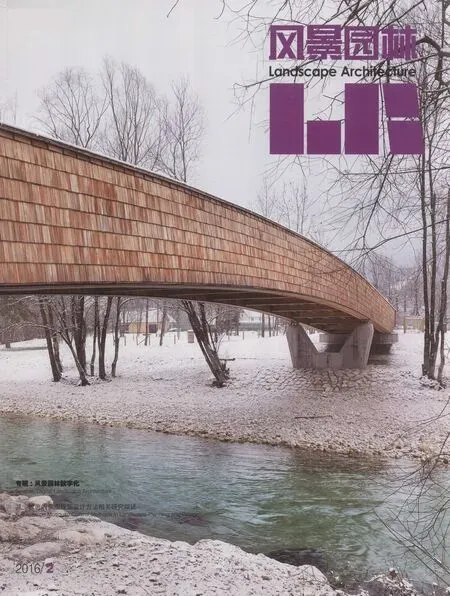刊首语
刊首语
当今是以计算机和网络技术为代表的信息时代,我们的生活早已与数字技术产生了密切的关系。几乎身边的每一个人都在使用电脑、手机等数字产品,一有时间就在刷新微信朋友圈,连不久前的春节联欢晚会也演变成了抢红包大战。数字技术早已悄悄地像病毒一样侵入到我们每一个人的生活当中。
数字技术是一项与电子计算机相伴相生的科学技术,它可以借助一定的设备将许多复杂多变的信息转变为可以度量的数字或数据,再凭借这些数字、数据建立起适当的数字化模型,引入计算机内部进行统一处理。数字技术的出现带给了这个世界无限的可能性,使工作和生活更加高效、便利。
将风景园林学科与数字技术相结合,也带来了风景园林行业的诸多变化。它不仅有助于我们提高工作的效能,进行科学的定量分析,更有助于我们解读风景园林这一复杂的动态系统。从前期分析、中间的设计构思,到设计的图纸表达,一直到项目的最终建造过程,在风景园林实践项目实施的各个环节,数字技术都已经开始得到广泛应用。地理信息系统(GIS)、物理环境分析技术、参数化设计、运算生成设计、建筑信息模型(BIM)、数字图解与虚拟现实、数控建造以及数字管理……一系列的新技术层出不穷。每一位从业者也都开始或多或少地接触数字技术,利用这些技术来完成一些之前仅靠双手无法完成的工作。
风景园林数字化的推广,也对从业者提出了新的要求。基于数字化的设计思维更多倾向于数理逻辑思维,这就要求从业者的知识结构更加全面,思考方式更加理性、逻辑化。同时,如何实现艺术与技术的结合,如何完成两者的平衡,需要每一位从业者思考与探索。
尽管数字技术能够给我们提供科学定量的分析,却无法代替人类做出最终的决定,因为计算机暂时还无法代替人脑思考。因此,数字技术只能作为设计师的工具和助手,主体依然是我们每一位从业者。优秀作品能否产生,并不在于是否有更加先进的技术,而是取决于设计者的思想。
每一项新事物的出现总是伴随着肯定与争议,关于数字技术的研究越发全面多元,针对它的质疑和反思也从未停止。但是,正是这种不断的思考、探讨和论证,才促进了理论与技术的不断进步和持续发展。
本期围绕风景园林数字化,选取刊登了5篇相关文章,它们涉及多个方向,包括编程技术辅助规划设计的方法、计算机辅助建造技术在风景园林规划设计中的应用、海绵城市水文模型、基于多源大数据的北京大型郊野公园的影响可视化研究、以及“人机交互技术”支持下的“动态”景观设计未来,献与读者,愿邀您与我们共同探讨这一主题。
Today is an information era that is based on digital computing technologies and internetwork. Our life has already relied heavily on the digital technology. Almost everyone around have computer, mobile phone or other digital products and very often use them. We have to admit that digital technology has played a key role in our modern life.
Digital technology or information technology is actually the application of computers and telecommunications equipment to store, transmit and manipulate the large amount of complex information. Then, with the techniques and computer programs,process the data, which could be considered a subset of information and communications technology. Such technology indeed gives us the infinite possibilities and surprise, and also makes work much more efficient.
The same, it should bring new possibilities to the landscape architecture development if digital technology could integrate into landscape planning and design. Not only does digital technology help us to enhance work efficiency, also applies statistical and mathematical methods to cope with landscape architecture such complex dynamic system for decisionmaking. From the early site analysis to the design drawings and expressions until the final construction effect, digital technology has been widely used in each stage of landscape practices, which includes Geographic Information System (GIS), Geo-design,parametric design, Building Information Modeling (BIM), digital management and so on. Most landscape architects start to learn and attempt different digital technologies in their projects. With the special techniques, help them to finish something that cannot work only by hands.
As the growth of digital landscape architecture, force more requirements created for all practitioners. For instance, ask landscape architects to train mathematical logic thinking, this requires people to build up a comprehensive, more rational knowledge structures in mind. Meanwhile, landscape architects should also consider and research on how to realize the combination of art and technology, and how to maintain the balance of both.
Although digital technology would provide us with scientific and quantitative analysis, still cannot make the final decision,because the computer has no brain to think independently like human. Thus, the digital technology would only play as a designer tool or designer assistant, the main body still our landscape architects. The outstanding work should be determined only by designer's ideas, not the advanced technology.
The creation of every fresh thing is always accompanied by affirmation and controversy. By rapid development on digital technology, judgment and reflection also never stop talking about it. Exactly, just the constant consideration, argument and demonstration, promote the progress and sustainable development of the technology.
Focused on digital landscape architecture, this issue of Landscape Architecture Journal will publish five papers,including the method of programming technology aided landscape planning, the potential of computer-aided manufacturing technology in landscape architecture, hydrological and hydraulic models for “sponge city”, the research of the impact of the large-scale country park in Beijing based on multi-source data and future dynamic landscape design based on “human computer interaction”. Hope all readers will enjoy reading, learning and improving altogether.
PREFACE

